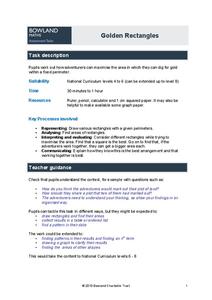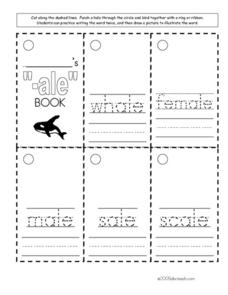Curated OER
Investigation--What's The Number?: Exponents
Eighth graders explore exponents and look for patterns that help to determine the ones place when the base is raised to any power. They use trial and error and seek general solutions. Also, identify patterns in a number sequence.
San José State University
Organizational Patterns for the Comparison/Contrast Essay
Organization is key in essay writing. The two organizational charts included in this resource model the block approach and the point-by-point approach to organizing a compare and contrast style essay. After examining the charts, writers...
Mathematics Assessment Project
Floor Pattern
You'll never look at floor tiles the same again. An assessment task prompts learners to investigate relationships between patterns involving squares and kites to determine angle measurements. They then prove whether a given quadrilateral...
Virginia Department of Education
Powers of Ten
Investigate negative exponents of-ten. Pupils use the pattern of increasing powers of 10 to determine negative powers of 10. The scholars write the powers in expanded and product forms and make the connection to exponents using a...
Illustrative Mathematics
Seven to the What?!?
Sometimes what seems like the easiest problem is really the most difficult. Your class is first going to reach for their calculators, but will realize the number is too large to evaluate. Now what? This is where the fun and the logical...
Noyce Foundation
Tri-Triangles
Develop an understanding of algebraic sequences through an exploration of patterns. Five leveled problems target grade levels from elementary through high school. Each problem asks young mathematicians to recognize a geometric pattern....
Curated OER
Guess That Sequence!
Students explore number sense by completing problems in class. In this patterns lesson plan, students examine a group of numbers and identify what the pattern is and how it should correctly continue. Students practice utilizing number...
Curated OER
Morning Math
Get your morning mathematicians thinking with this set of warm-ups. You can do them all in one day, or separate them and have kids do one each day. They will review past concepts and sharpen newer ones with this assortment of problems...
Bowland
Golden Rectangles
Scholars must determine the maximum area for a rectangular plot of land enclosed with 100 meters of rope. As the work they discover patterns and numerical approaches to solve the problem.
AGradeMath.com
Working With the 10,000 Chart
Calculate the answers to problems that are multiples of ten to help your class discern patterns in the zeros and learn to sequence. Each person receives a 10,000 chart, but s/he must discover that on their own through estimation and...
EngageNY
Relationships Between Two Numerical Variables
Is there another way to view whether the data is linear or not? Class members work alone and in pairs to create scatter plots in order to determine whether there is a linear pattern or not. The exit ticket provides a quick way to...
It's About Time
Atoms with More Than One Electron
Provide young chemists with the ability to manipulate atoms and predict their results, in this sixth lesson. Pupils analyze energy patterns as they predict the amount of energy required to remove electrons from atoms. They compare trends...
Curated OER
Bugs Take Shape
Students investigate butterflies, moths, ladybugs and spiders looking at shapes, colors and patterns. They create a three dimensional bug using Crayola Model Magic, repeating patterns found in nature. They cut and shape the dough using...
Curated OER
The -ale Ending
This is a very useful resource to use with younger or special needs learners. It includes five printable worksheets which all reinforce the -ale ending and spelling pattern. Printing practice, fill in the blank, complete the pattern, and...
Hawaiʻi State Department of Education
Rhythm Patterns
Fractions can be tricky. Why not have kids think of fractions like they think of eighth, quarter, and half notes? In teams, the class creates four-measure patterns with their percussion instruments. They need to explain their rhythm...
Kenan Fellows
Dinner Party: Using Pattern Trains to Demonstrate Linear Functions
Nothing fancy here ... just your run-of-the-mill Algebra party! Learners explore the patterns of linear functions while designing seating arrangements for a dinner party. Comparing the number of tables to the perimeter of the combined...
Curated OER
Fill the Number Grid
Patterns emerge as the class works together to fill in a number grid. This whole group activity is designed to make all learners feel successful, and ultimately turns into a lesson on the least common multiple.
Curated OER
Find the Pictures
There are hidden pictures here, but scholars must find the rhyming words to uncover them. They follow directions by coloring in only the shapes that rhyme with a given sound. Although the pictures aren't that well hidden, this puts a fun...
DK Publishing
3 Times Table
This 25-chart will give mathematicians a chance to detect patterns as they shade in every multiple of three by skip counting. They solve multiplication number sentences involving three and the numbers 1-5 (one is done for them.) Finally,...
DK Publishing
Learning 10 - Write the Number
Already covered numbers 0-9? It's time to focus on 10 with this set of exercises. First, youngsters trace the number 10 three times and try printing it a couple of times on their own. Next, they count five sets of bottles and write the...
DK Publishing
Learning 7 - Write the Number
Encourage number confidence by focusing on one number at a time; young counters examine the number seven, starting by tracing the numeral three times and printing a few more on their own. Next, they count three sets of flowers in an...
DK Publishing
Learning 9 - Write the Number
As novice counters learn numbers 0-10, use this exercise to focus on the number nine. They begin by tracing and printing the numeral several times. Next, learners count sets of stars and record the totals, all of which are nine....
Curated OER
Counting Forward or Back
What comes next? Young counters follow the stone path to each house, filling in numbers in a sequence as they go. Some of these move forward and some backward, but all progress by ones. Learners start with given numbers and then follow...
DK Publishing
Learning 8 - Write the Number
What's so great about the number eight? Novice counters explore this digit through four distinct activities. First, they trace the numeral three times before printing on their own. Next, they examine three houses with kids peeking out...
Other popular searches
- Geometric Number Patterns
- Extending Number Patterns
- Fibonacci Number Patterns
- Math Number Patterns
- Number Patterns Worksheets
- Odd and Even Number Patterns
- Number Patterns in Math
- Ab Number Patterns
- Looking for Number Patterns
- Recognizing Number Patterns
- Number Patterns and Sequences
- Patterns Hundred Chart

























